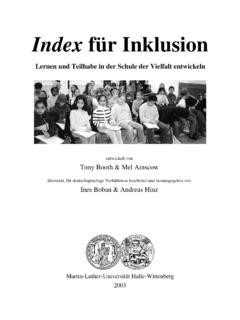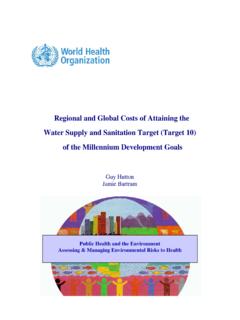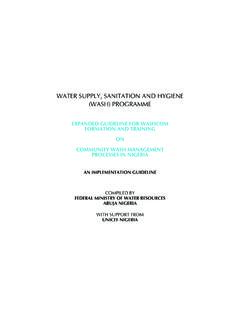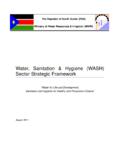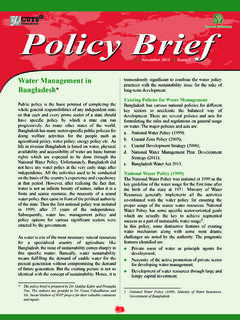Transcription of Water, Sanitation and Hygiene (WASH) Training Manual …
1 water Sanitation and Hygiene ( wash ). Training Manual for Schools with Rooftop Rainwater Harvesting Systems Acknowledgements This Manual was developed with much assistance, support and inspiration from many individuals and institutions. We would like to thank USAID Office of Foreign Disaster Assistance (OFDA) for their on-going partnership and shared commitment to improving the health and Sanitation of vulnerable communities in Zimbabwe. Many thanks also go to everyone on the IRD team who contributed to the creation of this Manual . Special thanks is extended to Danielle Roth for her outstanding efforts towards making this Manual a reality. Her dedication and hard work were central to the successful completion of this work. Additionally, I would like to acknowledge contributions from Budiriro 5 and Glen View 8 primary schools for their invaluable feedback.
2 water , Sanitation and Hygiene ( wash ) Training Manual for Schools with Rooftop Rainwater Harvesting Systems 2. Table of Contents 1. Introduction .. 5. Why this Manual ? ..5. How to use this Manual ? ..5. Toolkit Content ..6. 2. Methodology .. 7. Manual Development ..7. Participatory Tools and Techniques ..7. Branding ..8. Gender Considerations ..8. 3. Session Plans .. 9. Session 1: Healthy Bodies, Happy People ..9. Session 2: My water Sources ..12. Session 3: Clean water Requires Care ..15. Session 4: Rain, Rain Come Again ..18. Session 5: We Are water Warriors ..22. Session 6: Rainwater Harvesting Myths and Realities ..26. Session 7: Diseases Can Be Prevented ..29. Session 8: How Do We Get Sick? ..33. Session 9: Good Sanitation Keeps Me Smiling ..36. Session 10: I wash , wash , wash My Hands ..40. Session 11: There Is a Proper Way to Dispose of Litter.
3 43. Session 12: My Role in Good Hygiene ..46. Session 13: Maintaining My Healthy Body ..49. 4. References .. 51. water , Sanitation and Hygiene ( wash ) Training Manual for Schools with Rooftop Rainwater Harvesting Systems 3. Illustration Index Illustration 1: Introducing Ronaldo .. 8. Illustration 2: Student water mapping .. 14. Illustration 3: Ronaldo using WaterGuard .. 17. Illustration 4: A typical rainwater harvesting system .. 19. Illustration 5: Different components of a tank setup .. 22. Illustration 6: A tank in a bad state (Source UNICEF Maldives, Training Manual , 2008) .. 23. Illustration 7: A tank in a good state (Source UNICEF Maldives, Training Manual , 2008) .. 23. Illustration 8: Sugar Salt Solution Testing .. 30. Illustration 9: F-Diagram .. 33. Illustration 10: Your F-Diagram should look something like this.
4 34. Illustration 11: Example of a " Hygiene passport" .. 48. water , Sanitation and Hygiene ( wash ) Training Manual for Schools with Rooftop Rainwater Harvesting Systems 4. 1. Introduction International Relief and Development (IRD, USAID/OFDA produced the school Training Manual for Zimbabwean schools benefiting from rainwater harvesting systems. The purpose of this Manual is to educate primary school students about rainwater harvesting as a viable option for supplying water to schools in Zimbabwe and water , Sanitation , and Hygiene ( wash ) issues in general. Why this Manual ? In 2009, IRD began implementing the USAID/OFDA funded Peri-Urban Rooftop Rainwater Harvesting (PROOF) Program as a response to the cholera outbreaks in the high density areas surrounding Harare. From 2009-2011, IRD constructed more than 700 rainwater harvesting systems for use by households and primary schools.)
5 This Manual is designed as a tool for teachers at schools benefiting from the program to educate their students on the usage and care of the rainwater harvesting system. The Manual also addresses critical water , Sanitation , and Hygiene issues that play an important role in students' health and well-being. How to use this Manual ? While the IRD wash Manual can be used as a complement to the environmental science, home economics, and social studies curricula, it is best implemented as a whole package in and of itself. To this end, students will have a focused introduction to water , Sanitation and Hygiene ( wash ) issues. The sessions progress in a logical manner that first allow students to examine their current conditions and works backwards to identify sources of disease and preventative measures that can be taken to ensure good health.
6 Each of the thirteen sessions starts with a teacher information sheet to provide the teacher with background information for the session. Ideally, the sessions will be implemented sequentially, once a week, during a thirteen-week period. This time frame will give pupils enough time to process the information between sessions and develop an interest in the subject matter. water , Sanitation and Hygiene ( wash ) Training Manual for Schools with Rooftop Rainwater Harvesting Systems 5. Toolkit Content A toolkit has been developed as a companion document to the wash Manual . Instructions for conducting activities using each tool can be found in the toolkit. The contents of the toolkit include: Item Details of what the teacher needs Ronaldo's story One A4 paper Ronaldo's messages One A4 paper Ronaldo's Pictures Thirteen A4 papers Story without an ending pictures Nine A4 papers water chain pictures Five A4 papers Tendai the Investigator Story Two A4 papers Contamination quiz game One A4 paper water source pictures Four A4 papers Hygiene passport One A4 paper F-diagram pictures Multiple pictures on three A4 papers Environmental Hygiene pictures Four A4 papers water , Sanitation and Hygiene ( wash ) Training Manual for Schools with Rooftop Rainwater Harvesting Systems 6.
7 2. Methodology Manual Development A collaborative process shaped the development and imagination behind this Manual . Stakeholder participation included informal discussions with school heads, directed focus group discussions with teachers, and informal meetings at the Ministry of Health and United Nations Children's Fund (UNICEF). These insights helped shape the Manual which was then tested at various grade levels in one primary school. Following the testing sessions, the document was again modified to emerge in its current form. Participatory Tools and Techniques The school Training Manual utilizes participatory teaching tools and techniques such as song, drama, poems, competition and demonstration. These tools help to engage students, enabling them to become active participants in their own education. Using this methodology will assist pupils to retain the information longer and participate in a way that is meaningful.
8 Participatory teaching techniques involve a style of facilitation that encourages play and values students' insights regardless of whether they are right or wrong. Thus, facilitation of activities identified in the Manual requires additional energy and deviation from standard teaching styles. Ultimately, these tools and techniques will be rewarding for both teachers and students as knowledge grows and behavior change is realized. water , Sanitation and Hygiene ( wash ) Training Manual for Schools with Rooftop Rainwater Harvesting Systems 7. Branding Branding is best described as collective association of an image with an idea. The School Training Manual employs branding through a participatory character named Ronaldo. He is a soccer player who has taken a very personal interest in water , Sanitation , and Hygiene issues.
9 With each module there is an image of Ronaldo doing an activity related to the session's theme. In addition, each module contains a message from Ronaldo. This structure allows students to associate a positive role model with the performance of water , Sanitation , and Hygiene behaviors. Ronaldo also serves as a common thread to connect and introduce the sessions. Thus, while students may forget the specific sessions they receive they will remember Ronaldo and at least some of his key messages. In the testing of this Manual , the use of Ronaldo proved to be a great success. His appearance in each session is critical to the PROOF school Training curriculum as a whole. It should be noted that Ronaldo' as a name for the soccer player, was chosen for the peri-urban context; it can and should be changed to fit a different environment.
10 Illustration 1: Introducing Ronaldo Gender Considerations In many places around the world, water , Sanitation , and Hygiene issues are inherently women's issues. Women are responsible for water collection, the cleanliness of the home and its surroundings, as well as the care and health of children. While this is the reality in many communities, men must also be encouraged to take an equal and active role in water , Sanitation , and Hygiene . When they do, communities will benefit from increased mobilization around these issues and a larger group of community advocates. A. teacher can facilitate these behaviors in multiple ways: by acting as a positive role model him or herself, presenting positive role models in the community, discussing gender roles directly with students, assigning boys tasks that are typically reserved for girls, and presenting pictures or ideas to students that utilize flexible gender roles.







